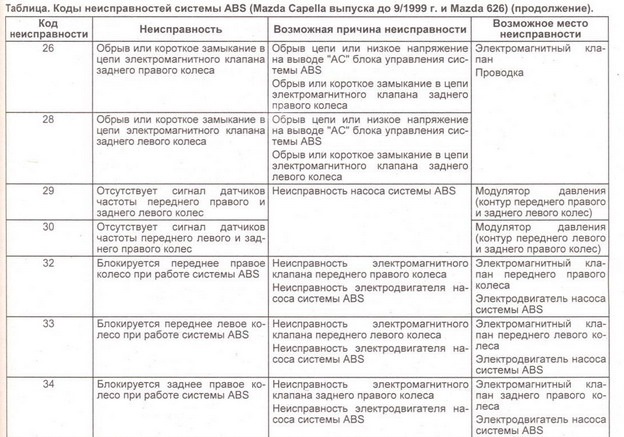Kodi Oshibok Mazda 626 Ge
- 11 Comments!

Sixth-generation Mazda 626 sedan Overview Manufacturer Production 1970–2002 Body and chassis (1970–1987) (1987–2002) Chronology Successor The Mazda Capella is a that was manufactured by from 1970 to 2002. Sold in the under the Capella name, the vehicle was also commonly known in other major markets as the Mazda 626., Mazda's partner at the time, would also use the Capella platform to create the. 4,345,279 of the 626 and Telstar models were sold worldwide. Designed to compete against Japanese mid-size stalwarts such as the,, and, the Capella would be succeeded by the (Atenza) in 2002. The car was named after, the brightest star in the, the in the night sky and the third-brightest in the northern, after. Hatchback (pre-facelift) For the fifth generation, GE series sedan and hatchback, the Capella name was dropped—although export markets retained the 626 title.
In this generation, there was no station wagon version in this line-up. Its nameplate replacements, the Mazda Cronos (sedan) and ɛ̃fini MS-6 (hatchback) that launched in November 1991 were pitched to Japanese customers instead.

394 np 0 1 387951 ge 53 tg 2 2 23392 END_DOMAIN. 6 0.00% 6 0.00%. 2 0.00% 2 0.00%. 1 0.00% 1 0.00%.
Both were slightly narrower than the export 626 saloons and hatchbacks to meet Japanese tax restrictions. Built on the, the hatchback-only MS-6 was launched under the brand, as a separate car from the sedan-only Cronos, as Mazda was at the beginning of an ambitious five-brand expansion plan of doubling sales. Including the (sold at Japanese Ford dealerships called Autorama), the coupe, and the, a total of five cars were spawned off the same platform, launched under four different brands in Japan over a two-year period. All of these models ended their production run prematurely, most likely due to the difficulties involved in promoting so many new nameplates as the Japanese economy began to feel the effects of the recession resulting from the from 1985-1991. While the MS-6 shared the Cronos GE platform, it was marketed as the more sporty of the two. The Capella badge lived on with the wagon/van versions on the previous GV series until 1999. Until 1989, used a car's width as a key determinant.
 The Cronos and its siblings all exceed the critical 1,700 mm (66.9 in) level in width. The series GE platform shared the same width dimension as the luxury brand and, sharing the 2.5-liter V6. Moving in accord with early-1990s, Mazda considered width a key factor in the Cronos' sales failure, and proceeded to create a narrower stopgap model from the. This car was introduced in 1994 as the new sedan.
The Cronos and its siblings all exceed the critical 1,700 mm (66.9 in) level in width. The series GE platform shared the same width dimension as the luxury brand and, sharing the 2.5-liter V6. Moving in accord with early-1990s, Mazda considered width a key factor in the Cronos' sales failure, and proceeded to create a narrower stopgap model from the. This car was introduced in 1994 as the new sedan.
Export Nonetheless, the GE Cronos and MS-6 continued to be sold as the Mazda 626 in nearly all export markets. European sales of the new 626 began in January 1992. The 626 was again magazine's for a second time in 1992. The European (E-spec) and Asian (JDM) models had many differences versus the North American (A-spec) models. These include: raised turn signal side markers vs the A-Spec flush mounted side markers, small fog lights with silver bezels vs the A-Spec full fitting fog lights, different interior cloth patterns, projector headlamps (glass lenses), a 1.8-liter FP engine, and a hatchback model. Europe also received a diesel-engined version, using the 'Comprex' pressure-wave supercharged RF engine seen in the previous generation JDM Capella. Power in Europe is 75 PS (55 kW) ECE at 4000 rpm, while the Japanese model claims 82 PS (60 kW) JIS at the same engine speed.
European models were also available in a model with four-wheel steering until a mid-1994 lineup adjustment. This was only offered in the hatchback with the 2.5-liter V6 and a manual transmission and not many were sold. For the first time for a Mazda, the 626 began manufacturing in the US at on 1 September 1992 for the 1993 model year. The car was originally known as the '626 Cronos' in Canada, but dropped the Cronos for the 1996 model year. Mazda's 2.5-liter debuted to rave reviews. Though the 626's manual transmission was highly regarded, four-cylinder 626s from 1994 onwards used the automatic transmission (designated by Mazda as LA4A-EL), which was an attempt to solve some of the 1993 model's transmission related issues.